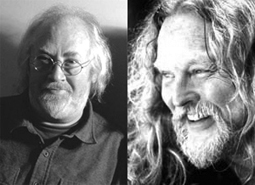Search
Rychard Carrington reports on John Renbourn and Robin Williamson – The Junction 2, Cambridge 19 April 2008

Tonight’s concert was a celebration of two outstanding musicians, whose distinctive contributions have graced the folk scene since the mid-60s. As always with good folk, though, the celebration and appreciation naturally expands out beyond musical talent to a broader sense of way of being and humane values that both music and personal presence communicate, from which one can draw up a picture of a culture that can be seen as a challenge to the mainstream, but also as one that is being lived successfully alongside it. Neither the folk revival of the early 1960s nor the hippy underground of the late 1960s remotely succeeded in redirecting mainstream culture – let alone politics – in the way they would have wished. Both, however, have expanded and enriched the array of alternatives offered by our ever-increasing cultural pluralism. It is our choice whether to explore the cultural roads less travelled, or to allow our culture to be determined by the controllers of mass media. Folk music, with very little big-business support, has contributed an optional cultural setting for many decades now. Be grateful, fellow concert-goers, for the opportunity we’ve had to select folk as a cultural background, rather than Big Brother.
Robin Williamson announced that they would be revisiting their influences from their days predating the Incredible String Band and Pentangle, and indeed it was the folk scene itself, especially as it was in the 1960s but as it has continued modestly since, that was celebrated tonight, rather than folk as a tradition that connects us to ancestors from earlier centuries than the twentieth. Williamson is Honorary Chief Bard of The Order of Bards, Ovates and Druids, yet tonight he appeared more as a seasoned beat troubadour, albeit possessed of a warm mellow glow far removed from Jack Kerouac. It was remarkable how many of the cited influences, the colourful characters the two encountered, hailed from the American folk scene of the early 1960s, despite the original influence here of left-wing movers and shakers who regarded America as the home of corrupt capitalist mass culture. Bob Dylan was covered twice, Jackson C. Frank once, and lesser known American visitors were remembered during the course of the evening, although the Williamson-Renbourn arrangements were always thoroughly distinctive, very far from the versions they had originally encountered (blues played with stringed harp, rather than mouth harp).
John Renbourn was the more retiring of the two. Williamson was the chief raconteur, and Williamson did the lion’s share (he does look slightly like a lion) of the singing – well, he has got the better voice. Renbourn’s chief contribution is his delightful acoustic guitar. His playing is unostentatious but quite delightful, a fine exemplar of the sheer pleasure that music can provide. He’s been there, he knows, and he just plays.
The combination of Renbourn’s guitar, Williamson’s harp and various pipes, the anecdotes and the songs’ sentiments confirmed the impression of folk music at its best as being something rather magical, yet essentially human in a hearteningly positive way.
Wryter: Rychard Carrington